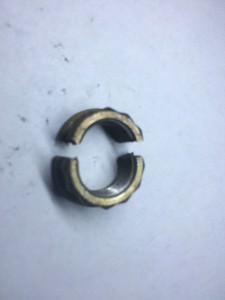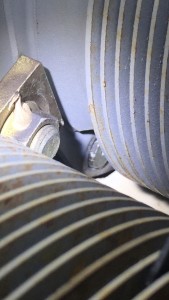Podcast: Play in new window | Download
March 25, 2016
The Monster of Complacency can:
- Terrify us with surprise when something happens unexpectedly.
- Cause us to overlook a potentially dangerous situation.
- Sometimes, it can be deadly.
Do you know what a “Rumble Strip” is? If not, listen to today’s episode to find out.
Whether you are a pilot, mechanic, or both, one way to guard against complacency is to assume you missed something, and it is your job to find it.
Here is the part that I had never seen broken before, in all my years of working on airplanes:
If you are familiar with Bonanzas, you may recognize this as the pin that fastens the retract arm to the wing fitting. This is an A36 Bonanza… congratulations for visiting the website, because I did not identify the type of airplane in the podcast.
Here is a view with a little more context of where we are looking in the gear well.
… and then the cylinder base nut that I found missing / broken:
Here are both ends of that stud:
Don’t be complacent… expect the unexpected!
Listen to today’s episode to find out 4 ideas of things you can do as an airplane owner, pilot, or mechanic, to be proactive in fighting complacency.
One last thing:
If you have a question you would like answered on a future show, please leave a comment below, or send me and email at deanshow@gmail.com
Thanks!





Dean, what a wonderful session. I couldn’t agree with you more. My flight instructor and flying friend have instilled in me the mentality that you always assume that something will go awry and to be prepared for the worst, and your podcast reinforces that we should always expect the unexpected. I carry this wisdom with me during my pre-flight checks and I will remember your suggestion to “look for that problem” in flight and to scan the panel expecting a problem.
During my first solo flight the Tach needle started bouncing around uncontrollably and RPM readings were unreliable. Fortunately, my instructor had encouraged me to also fly by the “sound” of the engine so as to not rely too heavily on the Tach. I’ve had two airspeed indicators (on two different planes) fail to come alive on the takeoff roll. In the first there was a clogged pitot tube and in the second the hinged cover was “stuck” and did not automatically open as it should have. These events occurred in the first few hours of my training and also imparted to me the importance of being proactive during every step from the pre-flight check to post-flight clean-up. When doing emergency simulations my CFI also recommends to not only assess what is “wrong” but to also evaluate what is still working.
I also appreciate that you addressed water and incorrect fuel type in the fuel tanks. I have never observed water after sumping or an unusual color/smell to the fuel, but will continue to be vigilant and avoid complacency.
Thanks again, Dean!
You’re welcome Elizabeth! And thanks for all your good ideas as well!